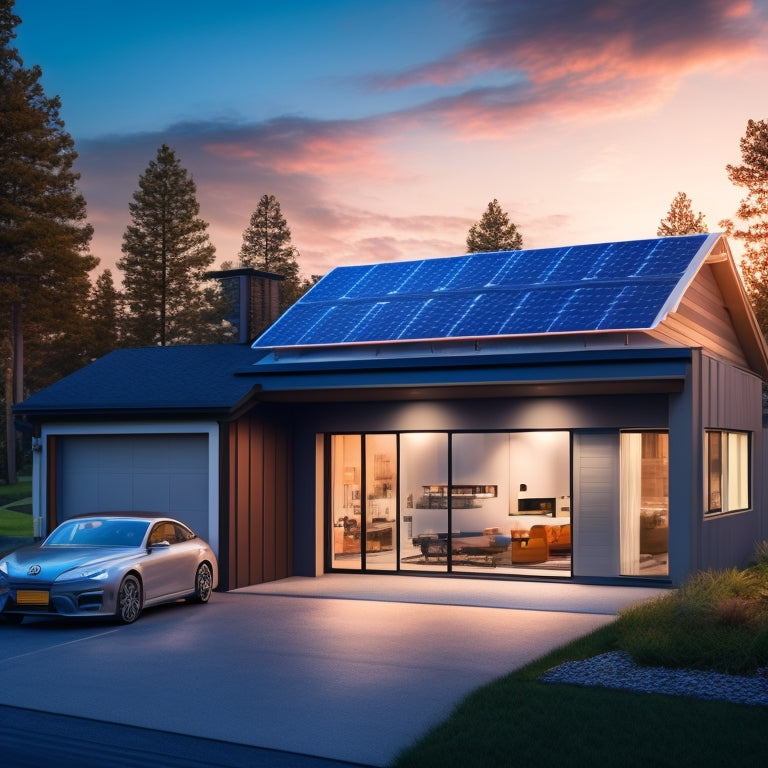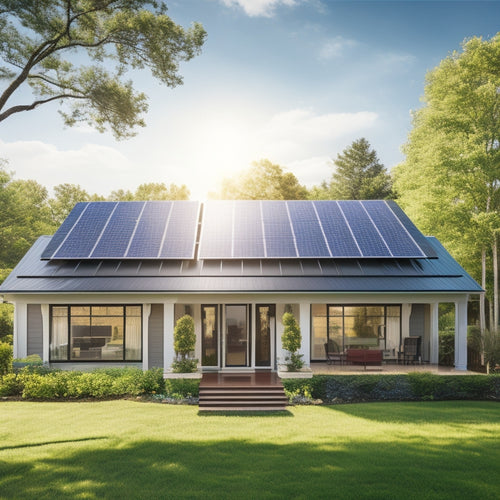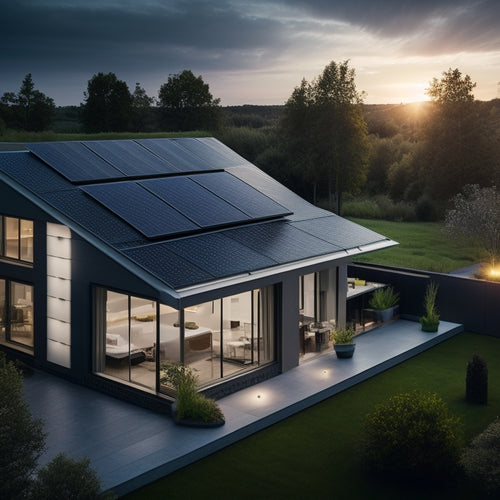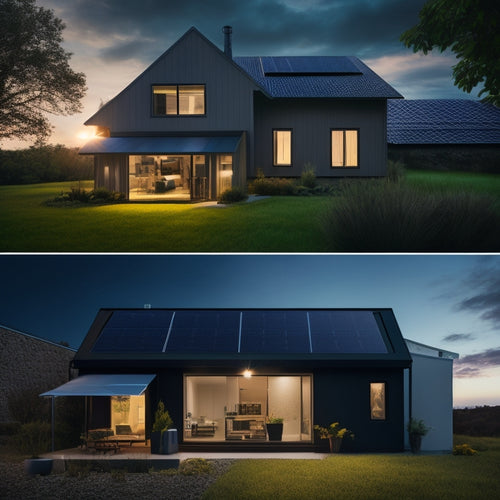
What You Need to Know About Home Energy Storage Setup
Share
Setting up home energy storage is a clever way to control your energy costs and enhance efficiency. You'll initially invest around $10,000, but the potential savings can reach $1,200 annually, making the payback period 8-10 years worthwhile. Energy storage reduces your reliance on fossil fuels, shrinking your carbon footprint while nurturing eco-friendly habits. Understanding battery capacity and efficiency is essential for optimizing performance and lifespan. Plus, aligning the system with your energy needs guarantees the most effective use of stored power. Keep exploring, and you'll uncover deeper understandings that can maximize the benefits of your energy setup.
At a Glance
- Home energy storage systems require an initial investment of approximately $10,000, with long-term savings potentially reaching $1,200 annually.
- Effective energy management and regular maintenance are essential for optimizing battery capacity and system performance.
- Integrating renewable energy sources, like solar panels, reduces reliance on fossil fuels and enhances environmental benefits.
- Understanding battery technology, including capacity and discharge rates, is crucial for selecting the right system for your needs.
- Assessing daily energy consumption patterns helps determine the appropriate storage capacity and optimize usage during peak and off-peak times.
Cost Savings Over Time
When considering a home energy storage setup, it's essential to weigh your initial investment against the potential savings over time.
By strategically utilizing and storing energy, you can achieve long-term energy independence, reducing your reliance on fluctuating utility rates.
Implementing effective energy management can optimize storage and consumption, enhancing the overall efficiency of your system, leading to greater cost-benefit analysis perceptions.
Ultimately, this investment not only pays off but also enables you to take control of your energy future.
Initial Investment vs. Savings
Investing in home energy storage can pay off considerably over time, but it is crucial to weigh the initial costs against potential long-term savings. The installation costs of a home energy storage system can vary widely depending on the technology and capacity you choose. However, understanding your financing options can help make this investment more manageable.
To illustrate the potential savings, consider the following table:
| Aspect | Initial Investment | Annual Savings |
|---|---|---|
| Installation Costs | $10,000 | - |
| Maintenance Costs | $200 | - |
| Energy Bill Reduction | - | $1,200 |
| Payback Period | - | 8-10 years |
Long-Term Energy Independence
Achieving long-term energy independence through home energy storage can greatly reduce your overall energy costs while providing stability against fluctuating energy prices. By investing in energy storage solutions, you're not just gaining a backup power source; you're adopting energy autonomy. This independence means you can produce and store your own energy, ultimately leading to significant savings over time.
Implementing self-sufficiency strategies, such as solar panels coupled with battery storage, allows you to utilize renewable energy. During peak sunlight hours, you generate excess energy, which can be stored for use during nights or cloudy days. This reduces your reliance on the grid and protects you from rising utility rates.
Over the years, the cumulative savings can be substantial. You'll not only save on monthly electric bills but also gain peace of mind knowing you're less vulnerable to external energy market fluctuations.
As you shift to a more self-sufficient lifestyle, you're taking control of your energy future. Welcome the freedom that comes with long-term energy independence and enjoy the financial benefits that follow. Your home can become a symbol of sustainability and resilience, enabling you in ways you never thought possible.
Environmental Impact Reduction
By investing in home energy storage, you're not just saving money; you're also taking significant steps to decrease your carbon footprint.
Implementing energy storage solutions allows you to capture excess solar energy for later use, further enhancing your renewable energy efficiency.
Utilizing renewable energy sources becomes more efficient, allowing you to utilize clean power while reducing reliance on fossil fuels.
This shift not only benefits your wallet but actively contributes to a healthier planet for future generations.
Decreasing Carbon Footprint
Often overlooked, home energy storage systems play a critical role in decreasing your carbon footprint. By storing excess energy generated during peak production times, you can use this clean energy when it's needed most, reducing reliance on fossil fuels. This proactive approach aligns with carbon offset strategies, allowing you to actively combat your greenhouse gas emissions.
Implementing a home energy storage system enables you to take control of your energy consumption, promoting sustainable living. You're not just reducing waste; you're maximizing the utility of renewable energy sources. The environmental benefits extend beyond the immediate energy savings; they contribute to a larger movement toward a greener planet.
When you choose to integrate energy storage into your home, you're making a statement about your commitment to the environment. This choice reflects a desire for freedom from traditional energy constraints and dependence on non-renewable resources.
Renewable Energy Utilization
Utilizing renewable energy sources is essential for minimizing environmental impact and promoting sustainability. By integrating solar panels into your home energy system, you can capture clean energy, drastically reducing your reliance on fossil fuels. This shift not only decreases your carbon footprint but also enables you to take control of your energy consumption.
When you examine grid connection options, you'll find that many utilities offer programs encouraging renewable energy adoption. These programs often allow you to sell excess energy back to the grid, turning your home into a mini power plant. This not only maximizes your investment in solar panel integration but also cultivates a sense of independence from traditional energy sources.
Moreover, renewable energy utilization contributes to a healthier planet, reducing air and water pollution associated with conventional energy production. By choosing to invest in sustainable solutions, you're actively participating in a larger movement toward environmental responsibility.
It's not just about energy savings; it's about creating a future where freedom from fossil fuels is a reality. So, welcome renewable energy, invest in solar technology, and take the first steps toward a greener, more liberated lifestyle.
Battery Capacity and Efficiency
When it comes to home energy storage, understanding battery capacity is essential for optimizing your system's performance.
Selecting the right battery type, such as lithium-ion or lead-acid, can impact efficiency and longevity. You'll want to maximize efficiency gains by selecting batteries that not only match your energy needs but also minimize losses during storage and retrieval.
For example, evaluating features like battery type and warranty can help guarantee you make an informed choice.
Understanding Battery Capacity
Understanding battery capacity is vital for anyone considering a home energy storage system, as it directly impacts how effectively you'll capture and employ renewable energy.
Battery capacity refers to the total amount of energy a battery can store, typically measured in kilowatt-hours (kWh). This measurement is significant because it determines how long you'll be able to power your home during outages or when solar energy production is low.
When you evaluate battery options, pay attention to battery chemistry. Different chemistries, like lithium-ion or lead-acid, have varying capacities and efficiencies.
Lithium-ion batteries often offer higher energy density and longer lifespans, making them a popular choice.
Another important factor is discharge rates, which indicate how quickly a battery can release stored energy. A battery with a high discharge rate can support your household during peak usage times, ensuring you've got the energy you need when you need it.
Maximizing Efficiency Gains
Maximizing the efficiency of your home energy storage system can greatly improve your overall energy management. To achieve this, start by understanding your battery's capacity and how it interacts with your energy needs.
Regular battery maintenance is essential; keeping terminals clean and ensuring proper ventilation can prevent performance degradation.
Consider the charging cycles too. Ideal charging times can enhance efficiency, especially if you take advantage of off-peak electricity rates.
By monitoring your battery's state of charge, you can prevent overcharging, which not only extends battery life but also maximizes energy output when you need it most.
Using a smart energy management system can help you track consumption patterns, allowing you to refine your energy use and storage capacity.
You'll find it liberating to rely less on the grid and utilize the full potential of your stored energy, especially during peak hours.
Selecting Based on Energy Usage
To effectively choose a home energy storage system, you first need to assess your daily energy needs. Understanding how much energy you consume and when you use it most can help you select a system that ideally meets your requirements.
By evaluating your peak usage times, you'll guarantee that your storage solution provides sufficient power when you need it the most.
Additionally, considering factors such as energy efficiency ratings and the specific characteristics of different battery types can further enhance your decision-making process.
Assess Daily Energy Needs
Evaluating your daily energy needs is essential when considering a home energy storage setup. Understanding your energy consumption patterns helps you determine the capacity you'll require. Conducting a daily usage analysis will guide you in making informed choices that align with your lifestyle and energy independence goals.
To assist you, here's a simple table to identify your key energy-consuming appliances:
| Appliance | Daily Usage (kWh) | Notes |
|---|---|---|
| Refrigerator | 1.2 | Runs 24/7 |
| HVAC System | 3.5 | Depends on climate |
| Lighting | 1.0 | Varies with habits |
Evaluate Peak Usage Times
Understanding when your energy consumption peaks can greatly impact your home energy storage setup. By evaluating your peak usage times, you can optimize your energy storage system to meet your specific needs. Typically, peak demand occurs during morning and evening hours when households are most active. Identifying these patterns allows you to utilize energy during off-peak times when rates are lower, storing it for later use.
Keep an eye on local energy trends, as they can influence your decision. For instance, if your utility company offers incentives for reducing demand during high usage periods, aligning your energy storage system with these trends can save you money. You'll gain not only financial freedom but also greater control over your energy consumption.
When you understand your peak usage times, you can effectively size your battery storage. Investing in a system that meets your peak demand guarantees you're never left in the dark during significant moments.
Ultimately, this knowledge equips you to make informed choices that enhance your energy independence and sustainability. So, take the time to analyze your consumption patterns; it's an essential step toward utilizing the full potential of home energy storage.
Longer Lifespan Than Competitors
When considering home energy storage, you'll want to focus on options that boast enhanced battery technology.
These advancements not only increase efficiency but also greatly extend the lifespan of your system compared to competitors.
Enhanced Battery Technology
In the domain of home energy storage, enhanced battery technology stands out for its ability to outlast competitors in lifespan and performance.
Solid state batteries represent a revolutionary leap forward, utilizing lithium innovations that offer greater energy density and improved thermal management. This means you can store more energy in a compact space while minimizing heat risks—an essential safety feature.
With modular systems, you can easily scale your energy storage solutions as your needs evolve. This scalability option not only supports your current energy demands but also prepares you for future expansions, ensuring you maintain your independence from the grid.
The smart integration of these systems allows seamless interaction with your home's energy use, optimizing efficiency.
Moreover, enhanced battery technology promotes sustainability through battery recycling initiatives, reducing waste while conserving precious materials.
When you choose a sturdy energy storage solution, you're not just investing in your home; you're embracing a lifestyle of freedom and self-sufficiency.
Frequently Asked Questions
What Are the Maintenance Requirements for Home Energy Storage Systems?
To guarantee battery longevity, you'll need to regularly check connections, keep the system clean, and monitor performance. Also, consider system upgrades to enhance efficiency, providing you with the freedom of reliable energy storage.
Can Solar Panels Be Integrated With Home Energy Storage?
Imagine utilizing the sun's energy, storing it effortlessly in solar battery integration. You'll enjoy energy efficiency benefits, maximizing your home's power potential while gaining independence from rising utility costs. Freedom and sustainability are within your grasp!
How Do I Monitor My Energy Storage Performance?
To monitor your energy storage performance, employ energy management software that tracks performance metrics. This approach enables you to optimize usage, ensuring your system works efficiently and enhances your energy independence. Control your energy future!
What Happens During a Power Outage?
During a power outage, you'll feel the effects of darkness enveloping your home, but with energy resilience, you'll utilize stored energy, keeping lights on and devices running—transforming chaos into comfort and freedom in your haven.
Are There Any Rebates or Incentives for Installing Energy Storage?
Yes, you can take advantage of federal incentives and state rebates for installing energy storage. These financial benefits not only reduce your upfront costs but also enhance your energy independence and sustainability, enabling your freedom.
Explore More
In summary, diving into home energy storage isn't just a smart move; it's like uncovering a treasure chest overflowing with savings and environmental benefits! Imagine slashing your energy bills while reducing your carbon footprint—it's practically a superhero for your wallet and the planet! With long-lasting batteries that outshine the competition, you'll feel like you've revealed the secret to energy independence. So, why wait? Utilize the power of home energy storage and change your home into an eco-friendly fortress today!
Related Posts
-

Home Solar Installation Cost
You're considering installing solar panels on your home, and the upfront cost is likely the biggest hurdle standing i...
-

Home Solar Battery
You're opting for a home solar battery that allows you to utilize the power of the sun during the day and use it at n...
-

Cost of Home Solar Battery
You're looking to invest in a home solar battery to reduce your grid reliance, but you're curious about the cost. The...


